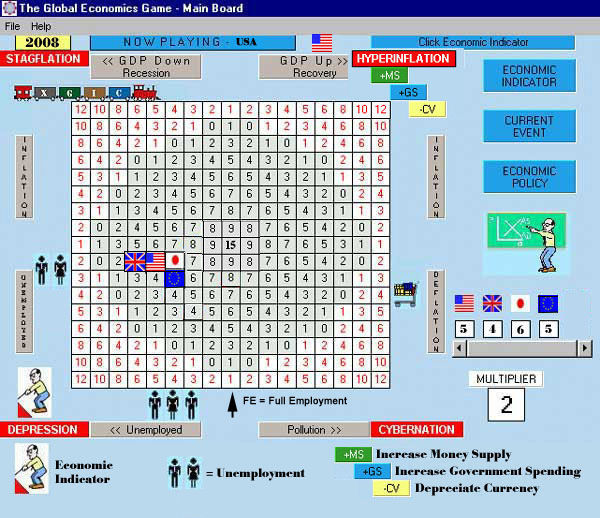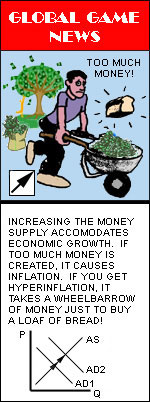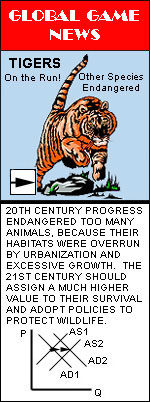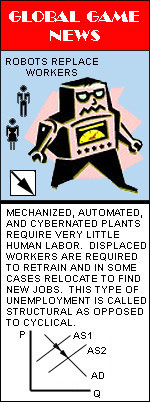
HOW THE GAME IS PLAYED
In The Global Economics Game each player is in charge of a country's economy. They are the chief economic advisers to the president, the congress, and the central bank of their countries. The object of the game is to be the best at selecting economic policies to maintain full employment, low inflation, and economic growth without excessive pollution.

The
Figure above shows the playing field of The Global
Economics Game. The best place for
a country to be is at full employment in the center square with the
number 15. The
United States, United Kingdom, Japan, and the Euro area countries
are not in the center square, they have unacceptable unemployment, and
they are
heading toward a depression in the lower left hand corner of the
playing
field. The Economic Indicator points
in that direction in 2008. The
Figure also shows that the most direct counter-cyclical
policy tools to get out of or to avoid a recession are:
1. Increase the Money Supply and, thereby,
lower interest rates to indirectly stimulate consumer and business
investment. 2. Increase Government
Spending for public
goods and services like infrastructure that will directly create new
jobs. 3.
Depreciate the Currency, which stimulates exports and curtails imports.
[For a more complete discussion of the global economy in 2008-09 see
this article: Another
Great Depression? - Why the Obama Stimulus Package Is Necessary].
Each square on the playing field of the main board represents a general economic situation. When your country's flag is in the very center of the playing area, your economy is in optimal or ideal balance. It is growing without causing excessive pollution. It has full employment of the labor force, but is not experiencing intolerable inflation. The very center of the playing area is the best possible place to land! The worst possible places to land are in the corners:
In the lower left corner, your economy is in a depression. Total spending for goods and services has declined. Production and incomes are falling, and unemployment is rising. The deeper into the corner you go, the worse it gets.
In the upper left corner, your economy is in stagflation. That's a recession combined with inflation and unemployment. This can be caused by natural disasters, rising resource costs, excessive regulation, or contrived shortages through production controls.
In the upper right corner, inflation is out of control. Hyperinflation is caused by too much spending and too much money. Skyrocketing prices are eroding the purchasing power of money, savings, and household income.
Down in the lower right area, you economy has ventured into cybernation. The dynamics of rapid technological and global changes are structurally displacing workers, causing greater income inequality, and generating unintended consequences of excessive pollution and other harmful environmental effects.
The object of the game is to stay out of the corners and accumulate the most points by landing in or near the center of the playing area as frequently as possible.
At the beginning of each turn, your country will move in the direction of the Economic Indicator. It represents the total market forces of aggregate supply and aggregate demand. These forces reflect the decisions of a multitude of households, businesses, and governments to spend and produce. Together, the forces of aggregate supply and aggregate demand combine to determine the direction of overall economic activity. Essentially, the Economic Indicator is a barometer and forecast of where the global economy is heading.
Sometimes the Economic Indicator unpredictably changes direction, just like in the real world. Economists refer to these changes as business cycles. They are recurrent, but non-periodic. That is, overall economic activity changes direction in unpredictable frequencies and patterns.
During each player's turn, a specific Current Event will occur. Stock prices may decline or there may be a bumper grain harvest. These events are selected randomly by the computer. They are independent of the Economic Indicator and may either reinforce or offset the general trend.
After your economy has moved in the direction of the Economic Indicator and the Current Event, you will have an opportunity to apply economic policies to move your country toward the center of the playing area. Fiscal, trade, and monetary policies are the three major policy tools:
Fiscal policy refers to government spending and taxation. One of the major features of fiscal policy is that budget matters are subject to the political process. Politicians may disagree about what government programs are the most important and how best to raise revenue to finance spending. Sometimes there can a significant time lag before the government can actually get spending and tax programs into motion.
To reflect the political character of fiscal policy, your available
options are limited. For example, if your country is in a
depression,
the appropriate policy would be to increase government spending.
However, you cannot implement an increase in government spending unless
you have the option. The timing and effectiveness of fiscal
policy
may be diminished by policy gridlock.
Trade policy manipulates exports, imports, and foreign investment flows. These policies are very important to the game, because they directly affect other countries. When you select a trade policy, your economy will move in one direction and another country's economy will be moved in the opposite direction. However, players are allowed to form free trade agreements to avoid the negative effects of protective trade policies.
Monetary policy is control of your economy's money supply, interest rates, and banking regulations. Unlike fiscal and trade policies, monetary policy is not generally subject to political constraints. An independent central bank can implement policy quickly. However, many economists estimate that there is a time lag before a given monetary policy begins to affect output, employment, and prices. To reflect this, your monetary policy will not take effect until your next turn.
Managing your country's economy will involve delicately balancing economic goals and policies in a volatile global context. The combined forces of aggregate supply and aggregate demand are powerful and dynamic. Effective economic policy responds as quickly as possible to the economic circumstances and changes as they occur.
Every game you play will be different
and
a new experience. You can play against other players or match
wits
against the computer. Win or lose, you will enjoy
playing
The Global Economics Game.
Business
Class Tickets - Visiting Different World Economies
Travel
Information - Business Class, Airfare/Airport Information
Questions and Inquiries: If you have any questions regarding the game or its application, please feel free to contact us at: Send E-mail to: econgame.
![]()
![]()
![]()
![]()
![]()
![]()
![]()
![]()
National flags represent each country and depict their economic position in the playing field.
Players can choose their country from a selection of more than 60 nations.
Original design visually displays goals and economic performance with simple icons.
The train moves with
the rate of economic growth:
Sinister
garbage cans indicate excessive pollution: ![]()
![]()
![]()
![]()
![]()
Currency
notes and shopping cart shrink with inflation: ![]()
Stark
gray
figures of unemployed workers stand motionless in depression: ![]()
![]()
Dialogue boxes explain terms such as
"Stagflation"
and "Depression" with a click of the mouse,
and there is a glossary
in the help menu. These features help students to become familiar
with
basic principles and institutions and acquire
an economics vocabulary.
Global Game News reports Current
Events which occur randomly during each player's turn.
Each current event includes a brief
description
of how Aggregate Demand and Aggregate Supply
are affected along with a corresponding
diagram.
Business orders pick up, stock markets crash,
there may be too much money, professional
athletes
strike, and robots replace workers. These
current events are visually appealing and
very instructive. They help students determine
which variables affect the demand side
of the market, which variables affect the supply
side, and how changes in aggregate demand
and aggregate supply alter the equilibrium
and overall performance of a given economy.



Professor
N.D. Cator explains how Aggregate Demand and Aggregate Supply interact
to determine the level of output, employment, and prices. He also
points to the direction of the Economic Indicator during the
game.
When you play the game against the computer, he is the economic adviser
to computer-managed countries.
Players use economic policies to manage their economies and get to the center of the playing area. Fiscal policy can effectively combat recession, and fine tuning options are available. However, fiscal options can be impeded by policy gridlock. Trade policy affects other countries. Currencies can be deliberately depreciated or appreciated. Free Trade Areas can be formed by mutual agreement. Monetary policy is flexible, but it has a time lag. Price controls are available, but they can backfire!
![]() Laissez
Faire Countries: These countries are programmed
to
move toward the center of the playing area most of the time. They
represent the neo-classical theory that market economies automatically
adjust to an economic imbalance. They can be very competitive
opponents
and are quite capable of winning the game!
Laissez
Faire Countries: These countries are programmed
to
move toward the center of the playing area most of the time. They
represent the neo-classical theory that market economies automatically
adjust to an economic imbalance. They can be very competitive
opponents
and are quite capable of winning the game!
The final score at the end of the game can be printed to hard copy, indicating the date and time.
The Global Economics Game is easy to learn for the first time by selecting tutorial from the CD's main menu. Each new game is exciting and fun to play. You can match wits against other players or against up to six computer managed or laissez faire countries. Winning requires concentration, prudent policy management, and some degree of good luck. Win or Lose, you will enjoy playing the game!
Questions and Inquiries:
If
you have any questions about how the game is played or its
applications, please feel free to contact us at: Send
E-mail to: econgame.
Return
to Home Page Information
for Educators
The World Game of
Economics
(C) 1999 Ronald W. Schuelke All Rights Reserved
The Global Economics
Game
(C) 2000-2004-2012 Ronald W. Schuelke All
Rights Reserved